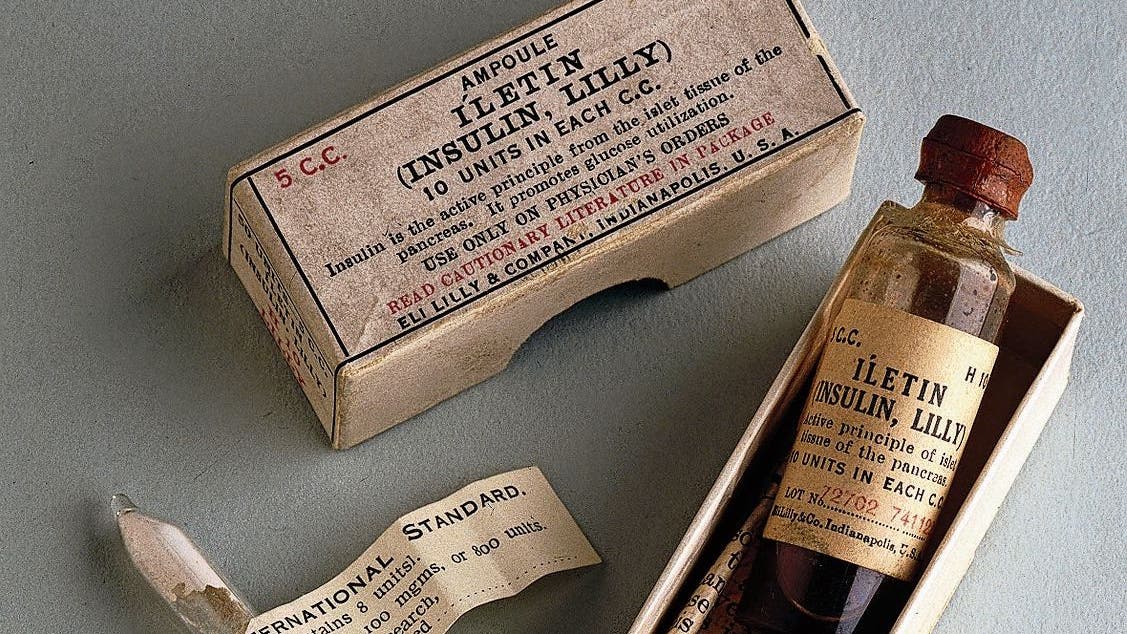Insulin
Suddenly no more death sentences: How science defeated diabetes 100 years ago
—
A hundred years ago, in the spring of 1921, Frederick Banting and Charles Best began the experiments on dogs that led to the manufacture of medical insulin. Diabetes had lost its horror.
—
Charles Best (left) and Frederick Banting (right) with an artificially diabetic dog that they had treated with the insulin they had taken from another dog. Insulin (Insulin Lilly) manufactured by Eli Lilly & Company as sold in the United States in 1923.
–
Insulin was a big thing. Then and still today. The first experiments began 100 years ago, in May 1921. The Nobel Prize followed in 1923. It was awarded to Frederick Banting (1841-1941), a hitherto quite unsuccessful Canadian doctor, and John James Rickard Macleod (1876-1935), professor of physiology at the University of Toronto, Canada.
They received the award because Banting and his assistant, medical student Charles Best, and a few others had managed to keep a patient suffering from severe diabetes alive for an extended period of time. The then 13-year-old Leonard Thompson had almost normal blood values again after only a few days of treatment with bovine insulin and only died 14 years later of pneumonia, not diabetes.
The award of the Nobel Prize illustrates that the story was by no means easy. There could be no question of a “discovery of insulin”; that this was the substance that could cure diabetes had been known for a long time. And why did the Scottish-born Professor Macleod get half of the prize money? Because he had left a laboratory and a couple of dogs through Banting and Best for the summer of 1921?
Obviously, the winners were also not very comfortable with the matter. Banting especially. He immediately distributed his half of the prize money with Best and almost at the same time violently against Macleod. And he immediately gave half of his prize money to the biochemist James Collip (1892–1965).
 –
–Insulin is still one of the most important weapons in medicine today.
–
Insulin had actually been “discovered” a long time ago
What happened? The story is even more complicated. The Romanian physiologist Nicolae Paulescu had already treated a dog with a pancreas extract in 1916, which he called pancrein. And he published his results in the spring / summer of 1921. If anyone is allowed to bear the title of «discoverer of insulin», it is him. However, the title itself is not without controversy, because you didn’t really have to “discover” or “find” anything. It was more about – to stay in the picture – to pick it up correctly.
Diabetes is a metabolic disorder. The hormone insulin causes cells to absorb carbohydrates from food from the blood. Without insulin, the blood sugar level rises and this damages the body. Until the 20th century, diabetes mellitus was a disease that sooner or later died. The doctors were helpless.
The only therapy available was extreme diets. The American doctor Frederick Allen (1879–1964) was known for this. He put his patients on extreme hunger diets of 1,000 calories a day or less (and one day of fasting a week). After all, they stayed alive for the time being.
A sleepless night and the birth of an idea
Frederick Banting was a farmer’s son who had studied medicine but was sent to the front in Europe in 1917, practically in the middle of his studies. In Cambrai, he received a splinter in his arm, but continued to operate unmoved and cared for the wounded. A certain stubbornness was already evident.
 –
–Frederick Banting
Doctor and physiologist
–
After his return he tried unsuccessfully to gain a foothold as a practicing doctor. In order to earn some extra money, he helped a colleague train young doctors. On Sunday evening, October 31, 1920, he was working on a lecture on the metabolism of carbohydrates. He had little idea of the subject. Then he read an article in a journal by a certain Moses Barron. He reported on the rare case of a stone in the pancreas. The stone was so big that it completely blocked the discharge from the pancreas, which caused the organ to atrophy.
Banting was electrified. He now knew – and research had been doing it for some time – that there were two types of cells in the pancreas. The “normal” ones, which produced digestive secretions, and the mysterious “Langerhans islands”, which were thought to make the diabetes-preventing hormone. So far it had not been possible to isolate this substance. Experiments had been carried out with pancreas extracts many times, also on humans, but without great success. Serious side effects with a noticeable decrease in blood sugar levels indicated that the substance was contaminated.
Why not tie off the pancreas outlet, wait and then extract the substance from the pancreas residue? That was Banting’s idea. And with that he marched to Macleod. He didn’t really care. Such a thing had often been tried unsuccessfully, but he finally gave in.
They died so that sick people could survive
Banting and Best operated dogs. For some, they blocked the pancreas exit and waited until only the islets of Langerhans were working. In others, they removed the pancreas entirely to make them diabetic. It must be said that surgeon Banting hadn’t gotten much better since Cambrai in 1918. The dogs suffered and died.
But on Saturday 30 July 1921 – Macleod was now on vacation in Scotland – Banting and Best “Dog 391” removed the stunted pancreas, extracted it and injected the solution into the artificially diabetic “Dog 410”. His blood counts got better almost instantly. Without the biochemist Collip and the expertise of Macleod, however, it would never have come about. Banting didn’t have a clue about biochemistry or blood sugar tests, and neither did Best much. But the team was quick, and it wasn’t far to medically usable insulin.
 –
–Insulin (Insulin Lilly) manufactured by Eli Lilly & Company as sold in the United States in 1923.
–
Macleod went back to Scotland angry, surprisingly little was heard from Collip in matters of insulin, but even more from Best. Both had long and successful careers in scientific research. Banting crashed in a Hudson bomber on February 20, 1941 on the way to England. A mysterious death.
 –
–Michael Bliss: The Discovery of Insulin. 1982; Jubiläumsausgabe 2007; Toronto University Press London.
–
–


